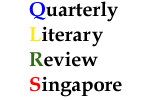 |
 |
|||||||||||||
|
By Paul Tan
The Sea In Blossom
The Anais Nin quote that opens Eunice Chew’s novel, The Sea in Blossom, augurs well: “And the day came when the risk it took to remain tight in the bud was more painful than the risk it took to blossom.”
This evocative line alludes to some of the broad themes in this novella of just over 100 pages – the theme of artistic creation and the attendant sacrifices that one makes for art, the compulsive need for an artist to express herself and the impossibility of keeping visceral feelings bottled within.
The narrative is straightforward enough. A sheltered Singapore girl grows up in Chinatown, studies art in Australia and forms an intimate friendship there with a laconic young photographer from Hongkong. He suddenly disappears one day and she is left to pine for him in lovelorn fashion for years, even as her career in the arts takes off in a dramatic fashion. This love story between the protagonist Ming En and photographer Hui is what drives the narrative. Through her wistful ruminations, readers get an insight into how a brief friendship, which teeters oh-so-closely to romance, can developed into such a life-changing force.
But what sinks The Sea is perhaps not the arguably clichéd plot. After all, literature and film is littered with instances of women who are able to cast a seemingly brief encounter into an epiphanic experience. Think of Ada Munroe in Cold Mountain, whose one stolen kiss with a conscript creates such intense longing and becomes a source of hope during the long war years . Or Francesca Johnson from The Bridges of Madison County whose four-day affair with a photographer changes her life irrevocably. (What is it with these rootless lensmen that women find so alluring?)
Nor is it the functionality of the language in the novel, which struggles to rise above the mundane and too plainly-spoken. After hearing Hui thank her and saying that he had learnt from her, Ming En is described as follows: “She was stunned... a sensation soared in her throat – she was not sure what, but she felt strangely and awkwardly shy.” The reader may get an idea of what Chew is trying to evoke but the result reads more like a maudlin teenage blog.
What to this reviewer is the novel’s weakest link is the shoddy editorial work and outright grammar errors. Throughout the novel, there are different tenses. Chew vacillates from present to past tense, sometimes within the same sentence!
On top of these grammatical lapses and peculiar conventions (such as not spelling out single-digit numbers), there are the garden variety typos and misspellings which only serve the compound the reader’s impression that the self-published writer did not turn to a professional editor.
There are a few tangents to the main narrative, just in case one imagines The Sea is only a love story. But like the main narrative arc, these subplots and characters too could have authentically and engagingly come to life in more skilful hands. Her brother-in-law reminds Ming En of Hui; her agent, who happens to be gay, suffers from a bad relationship; her sometimes tetchy sister is awkward to get along with; she meets a few vaguely interesting people during her Melbourne stay etc. Unfortunately the whole here is certainly less than the sum of these (walk-on) parts.
There are a few rare moments when Chew the writer succeeds in getting the reader to care for the protagonist. One instance is when she makes the link between the subjects of Ming En’s paintings and a larger psychology. “To her, seascapes, the cloud series and every shape and form of bird or wing or interpretation of flight; all those canvases – they were her only links to Hui, her way to relive every conversation, mood, look and question...”
Another such scene is at the end of the novel when Ming En finally meets the elusive Hui, and she finally comes to term with her protracted predicament. Without spoiling the surprise for the reader, she makes a decision that one genuinely feels like applauding. But most of the times, the novel, already marred with errors, leaves the reader unmoved or perhaps more kindly, wishing that we cared more for Ming En, that there was more for us to empathise and even learn from. As much as one wants to support Singaporean literature, any recommendation here would be a disservice, I feel, to our other published writers who face enough challenges being read and acknowledged on a larger platform.
_____
|
|
|||||||||||||
Copyright © 2004 The Authors
Privacy Policy | Terms of Use |
E-mail